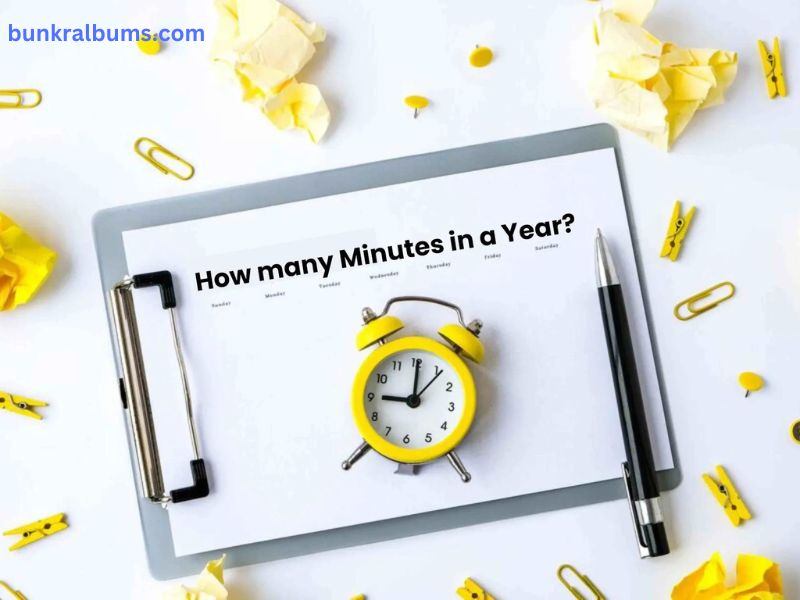Time is a fundamental aspect of human existence, intricately woven into the fabric of our daily lives. From the tick-tock of a clock to the changing seasons, time governs our routines, schedules, and even our perceptions of life itself. One of the simplest yet profound questions one might ask is, “How many minutes are in a year?” While the answer may seem straightforward at first, delving into the concept of time and its measurement reveals a rich tapestry of scientific, philosophical, and cultural dimensions.
The Mathematical Calculation
To answer the question of how many minutes are in a year, we begin with a basic understanding of the units of time.
- 1 minute = 60 seconds
- 1 hour = 60 minutes
- 1 day = 24 hours
- 1 year = 365 days (in a common year) or 366 days (in a leap year)
Now, let’s calculate the total number of minutes in a common year:
- Minutes in an Hour:
1 hour×60 minutes=60 minutes1 \text{ hour} \times 60 \text{ minutes} = 60 \text{ minutes} - Minutes in a Day:
24 hours/day×60 minutes/hour=1,440 minutes/day24 \text{ hours/day} \times 60 \text{ minutes/hour} = 1,440 \text{ minutes/day} - Minutes in a Common Year:
365 days/year×1,440 minutes/day=525,600 minutes/year365 \text{ days/year} \times 1,440 \text{ minutes/day} = 525,600 \text{ minutes/year}
So, a common year contains 525,600 minutes.
However, not all years are created equal. Every four years, we experience a leap year, which adds an extra day to the calendar:
- Minutes in a Leap Year:
366 days/year×1,440 minutes/day=527,040 minutes/year366 \text{ days/year} \times 1,440 \text{ minutes/day} = 527,040 \text{ minutes/year}
Therefore, a leap year contains 527,040 minutes.
The Concept of a Year: Solar and Lunar Cycles
To understand the significance of these calculations, it is essential to explore the concept of a year. A year is a unit of time that corresponds to the period it takes for the Earth to complete one orbit around the Sun. This is known as a solar year or tropical year.
- Solar Year: Approximately 365.24 days.
- Lunar Year: Based on the phases of the moon, approximately 354 days.
The Gregorian calendar, which is the most widely used calendar today, is based on the solar year. It is designed to keep the calendar year synchronized with the Earth’s orbit around the Sun. This is why we have leap years: to correct for the slight discrepancy between the calendar year (365 days) and the actual solar year (approximately 365.24 days).
The Cultural and Philosophical Significance of Time
Time is not merely a mathematical construct; it holds deep cultural and philosophical significance. Different cultures perceive and measure time in various ways, and this has influenced their calendars, rituals, and worldviews.
- Ancient Civilizations: The ancient Egyptians used a solar calendar, while the Babylonians based their calendar on lunar cycles. The Mayan calendar was remarkably sophisticated, incorporating both solar and lunar elements.
- Eastern Philosophies: In Eastern philosophies, such as Hinduism and Buddhism, time is often seen as cyclical, with the concept of reincarnation playing a central role. This contrasts with the linear perception of time in Western cultures, where time is often viewed as a finite resource that moves in a straight line from the past to the future.
- Religious Observances: Many religious observances are tied to specific times of the year. For example, the Islamic calendar is lunar-based, and the timing of Ramadan shifts each year relative to the Gregorian calendar. Similarly, the Jewish calendar is lunisolar, meaning it incorporates both lunar months and solar years.
Time in Modern Society
In the modern world, time has become an increasingly valuable and scarce resource. The phrase “time is money” encapsulates the economic value placed on time in contemporary society. The advent of technology, particularly the Internet and mobile devices, has accelerated the pace of life, leading to what some sociologists call “time compression.”
- Work and Leisure: The distinction between work and leisure time has become blurred in the digital age, with many people remaining connected to work through smartphones and laptops even during their personal time.
- Time Management: The concept of time management has gained prominence, with countless books, seminars, and apps dedicated to helping individuals make the most of their minutes.
- Globalization: As the world becomes more interconnected, the synchronization of time across different time zones has become critical for international business and communication.
The Science of Time: Relativity and Beyond
Albert Einstein’s theory of relativity revolutionized our understanding of time. According to relativity, time is not a fixed entity; it can be stretched or compressed depending on the observer’s speed and gravitational field. This leads to fascinating phenomena such as time dilation, where time passes more slowly for an object moving at a high velocity compared to one at rest.
- Time Dilation: This concept has been experimentally verified through observations of particles traveling at near-light speeds and clocks on fast-moving aircraft. While the effects are minuscule at everyday speeds, they become significant at relativistic speeds.
- The Arrow of Time: In physics, the “arrow of time” refers to the one-way direction of time, which aligns with the second law of thermodynamics: entropy (disorder) always increases in a closed system. This gives time its irreversible quality, as we experience it.
- Quantum Mechanics: In the realm of quantum mechanics, time behaves in even stranger ways. For instance, particles can appear to move backward in time under certain conditions, challenging our conventional understanding of temporal flow.
Measuring Time: From Sundials to Atomic Clocks
Humanity’s quest to measure time with precision has led to the development of various timekeeping devices throughout history:
- Sundials: One of the earliest methods of timekeeping, sundials use the position of the Sun’s shadow to indicate the time of day.
- Mechanical Clocks: The invention of mechanical clocks in the Middle Ages marked a significant advancement in timekeeping, allowing for more accurate measurement of hours and minutes.
- Atomic Clocks: Today, atomic clocks, which measure time based on the vibrations of atoms (typically cesium or rubidium), represent the pinnacle of accuracy. These clocks are so precise that they would lose only one second every millions of years.
- Coordinated Universal Time (UTC): Atomic clocks form the basis of Coordinated Universal Time (UTC), the time standard used worldwide. UTC is adjusted by “leap seconds” to account for irregularities in Earth’s rotation.
The Psychological Perception of Time
Interestingly, the way we perceive time is not always aligned with its actual passage. Several factors influence our subjective experience of time:
- Age: As people age, they often report that time seems to pass more quickly. This phenomenon may be due to the proportional theory, where each year represents a smaller fraction of a person’s total life span.
- Emotions: Emotional states can also alter our perception of time. For example, time may seem to slow down during moments of fear or danger, a phenomenon known as “time dilation.”
- Attention: When we are deeply focused or engaged in an activity, time can appear to fly by, while boredom can make time drag on.
The Future of Timekeeping
As technology continues to evolve, so too will our methods of measuring and managing time. Some exciting developments on the horizon include:
- Optical Clocks: Even more accurate than atomic clocks, optical clocks use lasers to measure the vibrations of atoms at optical frequencies. These could redefine the second in the future.
- Quantum Timekeeping: Quantum technology may lead to new ways of measuring time that could surpass even optical clocks in precision.
- Time Crystals: A theoretical concept in physics, time crystals are structures that repeat in time rather than space. If realized, they could revolutionize our understanding of time itself.
Conclusion
While the question “How many minutes are in a year?” can be answered with a simple mathematical calculation, the exploration of time as a concept reveals a vast and intricate landscape. Time is more than just numbers on a clock; it is a fundamental aspect of our existence that intersects with science, philosophy, culture, and technology. Whether contemplating the precise 525,600 minutes in a common year or pondering the mysteries of time dilation, we are reminded of the profound impact that time has on our lives.
In the end, time is both a constant and a variable—a measure of our days and the essence of our experiences. How we choose to spend those 525,600 minutes each year is ultimately a reflection of what we value most in life.







